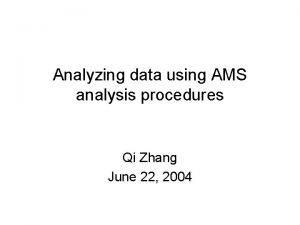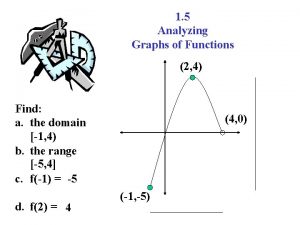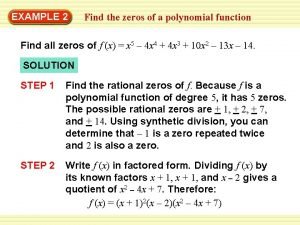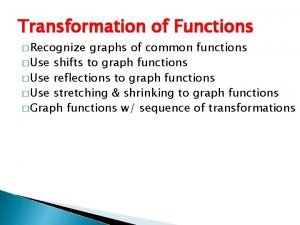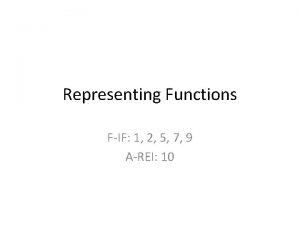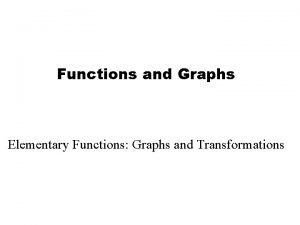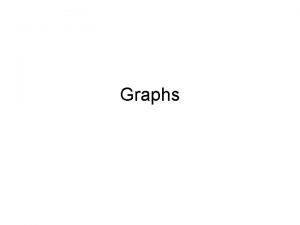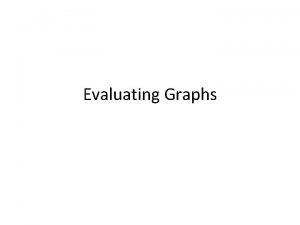UNIT 1 ANALYZING FUNCTIONS Analyzing Graphs FIF 4
















- Slides: 16

UNIT 1 ANALYZING FUNCTIONS

Analyzing Graphs F-IF. 4: For a function that models a relationship between two quantities, interpret key features of graphs and tables in terms of the quantities, and sketch graphs showing key features given a verbal description of the relationship. Mathematical Practice(s) • Attention to Precise • Make sense of problems and persevere in solving them

Identify how many key terms can you define? Leading Coefficient Rate of y-intercept End Behavior Change Decreasing Interval Degree Interval Notation Standard Linear Form. Zeroes Slope Domain Intervals Constant x-intercept Range Increasing Interval Roots

Writing Utensil Down

Identify the domain. Identify the range. Identify the increasing interval(s) in the function. Identify the decreasing interval(s) in the function.

Identify the end behavior. Identify the x-intercept(s). Identify the y-intercept(s). If we were not given the equation to the function, how could we determine the sign of the leading coefficient?

Identify the domain. Identify the range. Identify the increasing interval(s) in the function. Identify the decreasing interval(s) in the function.

Identify the end behavior. Identify the x-intercept(s). Identify the y-intercept(s). Is the leading coefficient positive or negative?

Identify the domain. Identify the range. Identify the increasing interval(s) in the function. Identify the decreasing interval(s) in the function.

Identify the end behavior. Identify the x-intercept(s). Identify the y-intercept(s). Is the leading coefficient positive or negative?

Identify the domain. Identify the range. Identify the increasing interval(s) in the function. Identify the decreasing interval(s) in the function. Identify the constant interval(s) in the function.

Identify the interval(s) when f (x) is positive. Identify the interval(s) when f (x) is negative. Identify each value below. f (-13) = f ( 2) = f (-5) = f ( 5) =

Identify the end behavior. Identify the x-intercept(s). Identify the y-intercept(s).

Identify the domain. Identify the range. Identify the increasing interval(s) in the function. Identify the decreasing interval(s) in the function. Identify the constant interval(s) in the function.

Identify the interval(s) when f (x) is positive. Identify the interval(s) when f (x) is negative. Identify each value below. f (-5) = f ( 0) = f (-1) = f ( 3) =

Identify the end behavior. Identify the x-intercept(s). Identify the y-intercept(s).
 Fif bali
Fif bali Fif airbeam
Fif airbeam End behaviour chart
End behaviour chart 1-2 analyzing graphs of functions and relations answers
1-2 analyzing graphs of functions and relations answers 1-2 analyzing graphs of functions and relations
1-2 analyzing graphs of functions and relations Analyzing graphs of functions
Analyzing graphs of functions 5-4 analyzing graphs of polynomial functions
5-4 analyzing graphs of polynomial functions Polynomial functions and their graphs
Polynomial functions and their graphs Analyzing graphs of functions
Analyzing graphs of functions 5-4 practice analyzing graphs of polynomial functions
5-4 practice analyzing graphs of polynomial functions Horizontal asymptote rule
Horizontal asymptote rule Zczc state graph
Zczc state graph Speed and velocity
Speed and velocity Graphs that enlighten and graphs that deceive
Graphs that enlighten and graphs that deceive Sort meaning
Sort meaning Domain of trig functions
Domain of trig functions Vertical stretch vs vertical shrink
Vertical stretch vs vertical shrink

